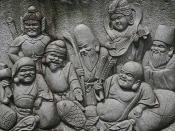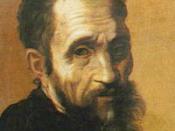Neo-Platonism had a profound influence on the Renaissance and the artwork of Michelangelo Buonarroti. During the Renaissance, Neo-Platonism enjoyed a revival in popularity. It was not thought of as being in opposition to Christianity. This is clearly seen in the works of Michelangelo.
Lorenzo de Medici was a prominent patron of the arts, and supported Marsilio Ficino and the Neo-Platonist Academy in Florence. It was here that Michelangelo got his early education. Michelangelo's philosophy of art was Neo-Platonic, and represented a departure from other theories of the time. Michelangelo believed that the artist's function was to bring preexistent forms out of the material at hand. Michelangelo was famous for his ability to harmonize the design of a statue with the proportions of the block of marble. Several artists had attempted to carve the block, which eventually became the David. It was too narrow for others to work with except for Michelangelo.
He was able to create a workable plan for the block. Michelangelo differed in this respect from many Renaissance theorists, who argued that art should reproduce nature.
Da Vinci advised painters to use mirrors to achieve conformity with the object being painted. This scientific view of art was further developed by Ghiberti. In his Commentaries, he argued that the mathematical proportions of the human body were the basis of its beauty. Alberti argued that artistic beauty was a process of mathematical averaging in which one could achieve harmony in proportion. This also allowed the elimination of imperfections by the natural objects by combining the most typical parts.
Michelangelo's theory of the concetto and intelleto was in opposition to these theories. He was often criticized for not faithfully representing his subjects. The statue of Lorenzo de Medici, for example, bore little resemblance to its subject. The Virgin of the...


